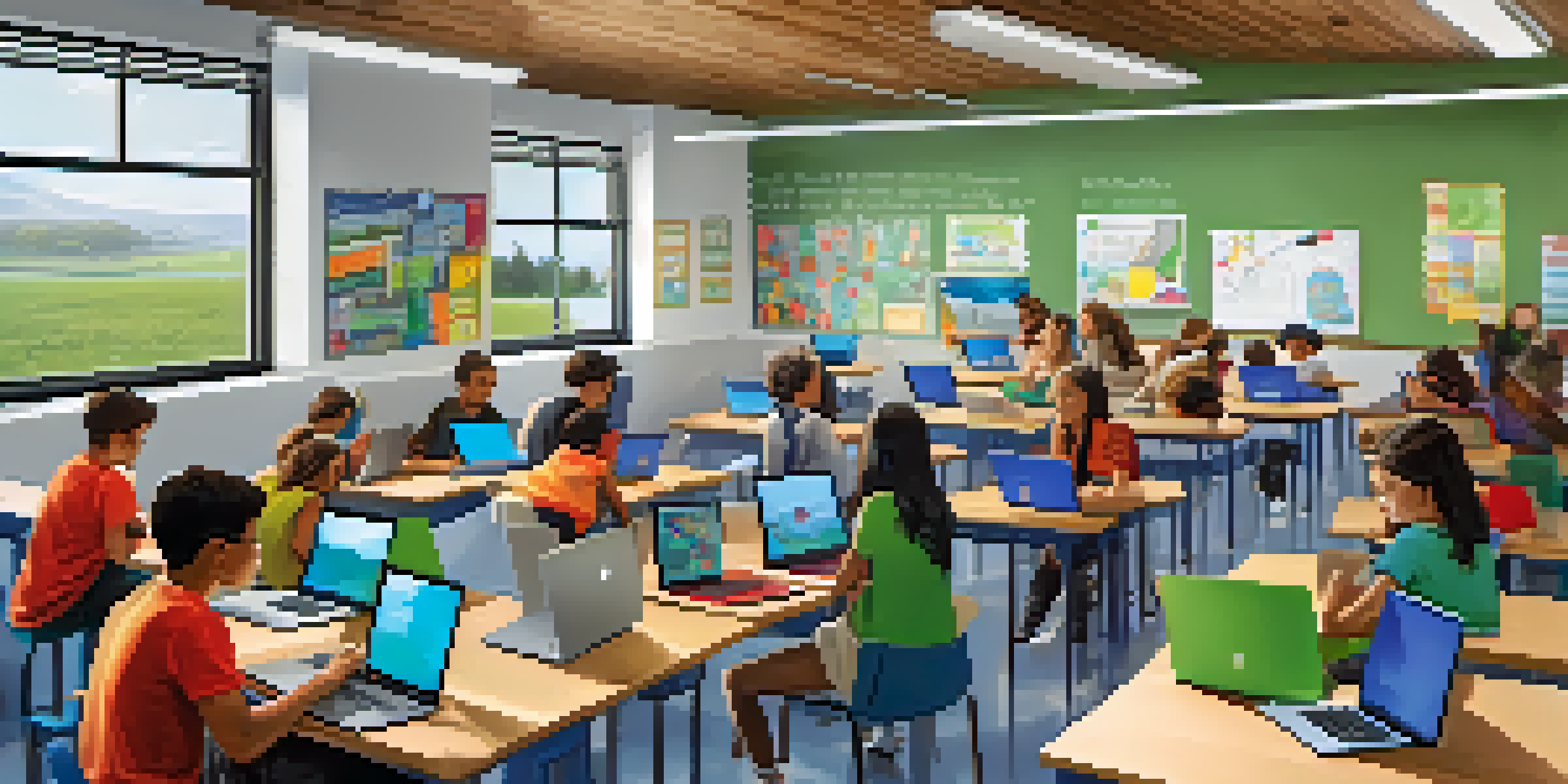Evaluating Student Progress in Blended Learning Environments

Understanding Blended Learning: A Brief Overview
Blended learning combines traditional classroom methods with online education. This approach offers flexibility and personalized learning experiences. By leveraging technology, educators can create a more engaging environment for students.
The only person who is educated is the one who has learned how to learn and change.
In blended learning, students often have the freedom to learn at their own pace, choosing when and how to engage with course materials. This model can cater to diverse learning styles, making education more accessible. Understanding this framework is crucial for effectively evaluating student progress.
As we delve into evaluation strategies, it’s important to recognize the unique dynamics of blended learning. By grasping how this model functions, educators can tailor their assessments to better support student growth and achievement.
Defining Learning Objectives for Effective Assessment
Clear learning objectives serve as the foundation for assessing student progress. These objectives outline what students should know and be able to do by the end of a course. Without well-defined goals, it’s challenging to measure success.

When creating learning objectives, it's beneficial to use the SMART criteria—Specific, Measurable, Achievable, Relevant, and Time-bound. This ensures that objectives are clear and attainable. By aligning assessments with these objectives, educators can gauge whether students are meeting expectations.
Blended Learning Enhances Flexibility
Blended learning merges traditional and online methods, providing students with personalized and flexible educational experiences.
Ultimately, defining these objectives not only helps in evaluation but also clarifies the learning path for students. This transparency fosters accountability and encourages students to take ownership of their learning journey.
Utilizing Formative Assessments for Continuous Feedback
Formative assessments are essential in blended learning environments, providing ongoing feedback to both students and instructors. These assessments can take various forms, such as quizzes, discussions, or reflective journals. The goal is to monitor student learning and identify areas for improvement.
Education is not the filling of a pail, but the lighting of a fire.
The beauty of formative assessments lies in their immediacy; they allow educators to adjust their teaching strategies in real time. For instance, if many students struggle with a concept, an instructor can revisit it before moving on. This flexibility is particularly valuable in blended learning, where pacing can differ among students.
Moreover, formative assessments encourage a growth mindset by emphasizing progress over perfection. Students can see their own development and adjust their learning strategies accordingly, making the learning process more engaging and effective.
Summative Assessments: Measuring Learning Outcomes
While formative assessments are about ongoing feedback, summative assessments evaluate student learning at the end of an instructional unit. These assessments often take the form of final projects, exams, or portfolios. Summative assessments are crucial for measuring whether learning objectives have been met.
In blended learning settings, summative assessments can be adapted to include digital components, such as online presentations or e-portfolios. This integration not only showcases student work but also reflects the blended nature of the learning environment. It’s important to ensure these assessments are aligned with the previously defined learning objectives.
Formative Assessments Drive Growth
Utilizing formative assessments allows educators to give ongoing feedback, helping students improve and adapt their learning strategies.
Ultimately, summative assessments provide a comprehensive snapshot of student progress. They help educators evaluate the overall effectiveness of their teaching strategies and make informed decisions for future instruction.
Incorporating Peer Assessments to Foster Collaboration
Peer assessments involve students evaluating each other's work, which can enhance learning in blended environments. This process encourages collaboration and critical thinking, as students must articulate feedback clearly and constructively. It also allows them to engage with diverse perspectives.
By incorporating peer assessments, educators can create a sense of community within the classroom. Students feel more connected to one another, which can improve motivation and engagement. Additionally, peer evaluations can lighten the assessment load on instructors, allowing them to focus on more complex evaluation tasks.
In essence, peer assessments not only support individual learning but also promote social learning. This collaborative approach mirrors real-world scenarios where feedback is crucial for growth and improvement.
Leveraging Technology for Enhanced Evaluation Techniques
Technology plays a pivotal role in evaluating student progress within blended learning environments. Tools like learning management systems (LMS) facilitate the tracking of student performance and engagement. These platforms can provide valuable data that informs instruction and assessment.
In addition to tracking, technology can enhance the assessment experience through interactive quizzes and multimedia projects. For example, an educator might use video submissions to allow students to demonstrate their understanding creatively. This not only caters to various learning styles but also makes assessment more engaging.
Innovative Assessments Shape Future
The future of assessment in blended learning lies in competency-based methods and advanced technologies that personalize student evaluation.
Moreover, technology enables timely feedback, allowing students to reflect on their performance almost immediately. This quick turnaround can motivate students to improve and adjust their strategies based on real-time data.
Addressing Challenges in Assessing Student Progress
Evaluating student progress in blended learning can present unique challenges. One common issue is ensuring consistent engagement from all students, especially in online components. Some students may struggle with self-motivation, making it difficult to assess their true understanding.
Another challenge lies in the diverse learning paces and styles present in blended environments. What works for one student may not resonate with another, complicating the assessment process. Educators must be adaptable and consider multiple assessment methods to accommodate these differences.

Despite these challenges, effective evaluation strategies can lead to meaningful insights into student progress. By being aware of potential hurdles, educators can proactively develop solutions that enhance the learning experience for everyone involved.
Future Directions: Evolving Assessment Practices
As blended learning continues to evolve, so too will assessment practices. Educators are increasingly adopting innovative approaches, such as competency-based assessments, which focus on students demonstrating mastery of skills rather than simply completing tasks. This shift emphasizes the importance of understanding over rote memorization.
Moreover, the integration of artificial intelligence and data analytics in education is on the rise. These technologies can provide deeper insights into student performance and learning patterns, allowing for more personalized assessments. This adaptability is crucial in meeting the diverse needs of learners in blended environments.
Looking ahead, the goal is to create assessment practices that not only measure progress but also inspire a love for learning. By embracing change and innovation, educators can enhance the effectiveness of their evaluations and support student growth in meaningful ways.